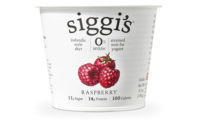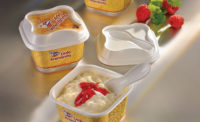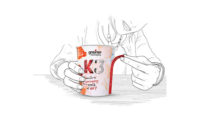With a projected compound annual growth rate of 2.9% through 2022, demand for food packaging reflects growth in the U.S. food industry overall, according to Food Packaging Trends & Advances, a report published in September 2015 by PMMI, The Association for Packaging and Processing Technologies, Reston, Va. Globally, growth is even stronger.
With a projected 5.3% annual growth rate, the report positions the dairy category mid-range, stronger than snack foods, but not quite as robust as meat and related products.
Innovations in dairy food packaging address each of the five trends identified in the report: sustainability, flexibility, convenience, technology and safety. With respect to convenience, dairy-based snacks use packaging with easy-to-open and close features. Packaging formats like portion-control are also popular.
More sustainable
Sustainability is spurring demand for lightweight packaging, and recyclable and/or renewably sourced materials. It also is boosting interest in transitioning from heavier rigid packaging to flexible packaging and “locavorism,” which relies on nearby sources of ingredients and materials to reduce transportation distances and carbon footprint.
Lightweight flexible packaging is a popular choice for dairy-based snacks, and it is especially well-suited for segregating single servings such as Sargento Natural Blends Cheese Snacks from Sargento Foods Inc., Plymouth, Wis. Each 80-calorie cheese stick resides in an easy-peel thermoform-fill-seal pouch. To simplify handling at point of sale, two strips of cheese sticks are loaded into a 12-count secondary pouch.
BelGioioso Cheese Inc., Green Bay, Wis., takes a slightly different approach to flexible packaging, using pouches that hold three bite-size pieces of the company’s Fontina Snacking Cheese. A secondary package, a 6-ounce pouch, holds eight 0.75-ounce, 70-calorie portions.
Renewable plant-based containers are a reality in Europe where RPC Promens Consumer Nordics, Kolding, Denmark, has developed a 1-liter milk bottle made entirely from a biopolymer produced from sugar cane. Skånemejerier AB, a dairy in Malmö, Sweden, has adopted the white blowmolded Modul bottle for its nonhomogenized milk products.
“Sustainability is a vital consideration throughout all our operations including our packaging, where we always seek to choose a solution with minimal impact on the environment,” said Armina Nilsson, sustainability manager at Skånemejerier. The Modul bottle is available with a choice of closures and a pre-applied four-sided label.
More convenient
Demand for convenience drives interest in single-serve and on-the-go packaging, particularly for snacks. Other convenience features include dispensing closures, easy-open/reclose structures and dual-compartment packaging for mix-in products like the Chobani Greek yogurt Flip line from Chobani LLC, Norwich, N.Y.
A variation of the dual-compartment package for The Laughing Cow Cheese Dippers serves the on-the-go consumer and addresses rising demand for dairy-based snacks. Most (73%) U.S. consumers snack on-the-go, according to The Snacking Occasion, a study published in 2014 by Mintel, London. This behavior is strongest among young millennial consumers, with 85% eating snacks on-the-go.
The single-serving Cheese Dippers positions a creamy cheese dip in one compartment and crunchy breadsticks in the other.
“Parents are looking for on-the-go snacks that not only their children can enjoy, but they can love as well,” said Dan Waters, chief marketing officer at Bel Brands USA, Chicago, the parent company of The Laughing Cow. “We have seen the popularity of dipping options increase recently, and we saw an opportunity to leverage the trend and satisfy our consumer’s needs with this new product,” he added.
Another package designed for on-the-go snacking is the EasySnacking container from RPC Superfos, Taastrup, Denmark. It features a one-piece injection-molded spoon in the lid and a space-saving stackable design. Ideal for products such as ice cream and yogurt, the container is available in two sizes – 210 milliliters (7.1 ounces) and 300 milliliters (10.1 ounces) – and compatible with microwaves, dishwashers and freezers. It was a finalist in the Best Convenience/‘On-the-Go’ Packaging category in the World Food Innovation Awards organized by FoodBev Media Ltd., Bath, U.K.
Another award-winning package is a metal bowl with a foil lid that can be used in microwave and conventional ovens. The package, from Ardagh Group, Dublin, Ireland, speeds preparation of All in One Fondü from Emmi AG, Lucerne, Switzerland. The bowl concept, which began as a collaborative project between Ardagh and students at the University of Twente, Enschede, The Netherlands, was developed at Ardagh’s R&D Center in Crosmieres, France.
“Together with Emmi and the Fraunhofer Institute in Germany, we tested special food-safe lacquers to allow the bowl to be heated either in a microwave or a traditional oven and to be kept at the right temperature above a candle at the table,” said Woep Möller, chief commercial officer, Ardagh Group, Metal.
The multilayer lidstock includes an AluFix Retort Pro membrane from Amcor Flexibles, Zurich, Switzerland. Sealed onto a metal ring for secure closure, the lidstock maximizes product protection and shelf life, yet opens quickly and safely.
The package earned Ardagh and Amcor a 2016 Alufoil Trophy in the Consumer Convenience category.
“This concept is a clever combination of a number of packaging elements to create a highly original product,” said Louis Lindenberg, global packaging sustainability director for Unilever, Guildford, U.K, who served as head judge for the competition, sponsored by the European Aluminium Foil Association, Düsseldorf, Germany.
He concluded, “Fondues can be time consuming and messy due to the complexity of setting them up. But here we have a product where all the packaging works together to make the concept work.”
An inverted, wedge-shaped pouch with a valved fitment and flip-top closure enables one-handed, spoon-free dispensing of sour cream from Daisy Brand, Dallas. When opened the first time, the cap is twisted off, the tamper-evident pull tab is removed and the cap is replaced. Squeezing the 14-ounce package dispenses sour cream in a drip-free manner since flow halts as soon as squeezing stops. During and after dispensing, the valve prevents air ingress and helps protect product freshness.
Enhanced convenience, lower costs and reduced material consumption combine in a new flexible packaging concept from Barton Group, New York City. Transparent film makes it easy to see the product and remaining contents. Ideal for single servings, an 8-ounce Stand Up SqueezyStraw pouch costs less than $0.04 per unit, about $0.02 less than a paperboard carton of the same volume and can be filled at high speeds. With integral “straw,” the flexible package eliminates the need for accessories such as a straw or cup. In addition, the squeezable pouch maximizes evacuation of the milk. When empty, the pouch compresses into a small mass for efficient, low-cost disposal. Production occurs on a diecutter-equipped horizontal thermoform-fill-seal machine running a high-barrier coextrusion such as BNX film from Valfilm USA, Findlay, Ohio.
Barton Group licenses the SqueezyStraw pouch technology. Licensing and royalty fees are based on volume.
“There is a one-time $25,000 licensing fee. In the most popular sizes, the royalty is $0.005 (1/2 cent) per pouch on volumes of 50 million pouches a year,” said Lew Barton, CEO of Barton Group.
No licensing agreements had been signed as of press time, but Barton anticipates “commercial product launches later this year or early next year. [Upcoming] machine trials…include products for a few potential customers. One large Midwestern dairy is planning on attending the trials based on its interest in the SqueezyStraw pouch for several…products including milk, yogurt, iced tea and lemonade.”
More flexible
Modular design and easy setup and changeover maximize the flexibility of the Tetra Pak A3 ice cream filler from Tetra Pak Inc., Denton, Texas. Capable of an output of up to 300 ice cream cones per minute, the six-lane machine features three enhancements:
- A cone dispenser capable of handling a range of cones and cups
- An accurate, easy-to-operate chocolate sprayer
- A lid dispenser
The modules can be supplied separately for easy upgrading of existing equipment. Reduced waste, fewer stops and faster speeds boost efficiency and ensure consistent product quality. The ability to produce different products on one machine cuts costs.
“Our pilot tests show that customers can save up to 69,000 Euros per year on the cone dispenser alone, thanks to reduced wastage,” said Peter Lindstrom, category director at Tetra Pak.
Robots are another way to maximize flexibility and automate manual picking, packing and palletizing operations. For cheese packing applications, QComp Technologies Inc., Greenville, Wis., offers the stainless steel, washdown-compatible Solo Case Packer cell. Features of the modular, turnkey system include compliance with RIA and ANSI safety requirements, gentle product handling and inspection and data collection capabilities. A common frame is said to simplify installation and startup. Single-point guide rail adjustments and quick-change tooling and funnel guides expedite changeover.
Another robotic option from QComp Technologies relies on the YuMi collaborative robot from ABB Inc., Auburn Hills, Mich. The dual-arm robot safely works in close proximity with a human operator and requires about the same amount of space. Features include a built-in controller, 14 axes of motion, easy-to-deploy program, and camera-based inspection and vision guidance options.
Innovative technology
In addition to greater use of robotics and modular equipment design, technology advances include active or “smart” packaging features, recycling-friendly labels for polyethylene terephthalate containers, enhanced materials and in-mold labeling. White Wave Foods Co., Denver, is one of the first users of injection-molded containers with in-mold labels, now offered in the United States by Greiner Packaging, Pittston, Pa. The in-mold-labeled polypropylene cup holds 150 milliliters (5.1 ounces) of WhiteWave’s soy yogurt.
Technology advances aren’t limited to equipment and smart packaging. An innovative material for flexible packaging consists of a sealant skin layer made of a state-of-the-art, high hot-tack resin and a specially formulated core layer, which provides stiffness and toughness. The result is said to be superior runnability on high-speed vertical form-fill-seal equipment, leak resistance at a thinner film gauge and lower downtime. Called Sure Seal, these dairy pouch films from Liqui-Box Corp., Richmond, Va., won a Silver Achievement Award for Technical Innovation from the Flexible Packaging Association, Annapolis, Md.
Updated graphics reinforce brand identity
A redesign positions Jersey cow milk products made by Promised Land, Dallas, as a premium line. Colorful graphics not only communicate the brand’s indulgent core, but also identify seasonal flavors. New typefaces, color palettes and the more modern, Art Deco design of the clear, recyclable polyethylene terephthalate bottle reflect the evolution of the brand’s overall look and feel, while staying true to the heritage of its glass bottle. Ergonomic improvements address consumer complaints related to spillage.
Another redesign involves shredded Locatelli Pecorina Romano cheese from The Ambriola Co., West Caldwell, N.J. Imported from Italy, the cup-packed shredded cheese adopts elements from the brand’s wedge product.
“We decided to take the highly recognizable outer coating of our Locatelli wheel and apply that graphic to our grated cups,” said Ambriola CEO Phil Marfuggi.
An ergonomic bottle designed by Berlin Packaging, Chicago, for Olivio Spray Butter from Olivio Premium Products, Boston, replaces a package with a more industrial look and won a Bronze Award in the Food Category of a competition sponsored by the National Association of Container Distributors, Glen Ellyn, Ill. Inspired by the aesthetic of rustic imported olive oil bottles, the 8-ounce custom container elevates the brand with rounded angles, a more grippable elongated neck and a custom red or brown overcap that covers a fine mist sprayer. A custom shrink-sleeve label provides maximum real estate for brand messages.





